Introduction
Pumpkins are versatile vegetables that can be used for decorations, desserts, and even savory dishes. But have you ever wondered what the plant that produces these large, orange fruits looks like? In this article, we will explore the appearance of a pumpkin plant.
The Leaves
The leaves of a pumpkin plant are typically large and lobed, resembling those of a maple tree. They can vary in size, ranging from 4 to 12 inches in diameter. These leaves are green and often have a slightly fuzzy texture on the underside. Pumpkin leaves are essential to the growth of the plant as they provide the necessary nutrients through the process of photosynthesis.
The Stem
The stem of a pumpkin plant is thick and sturdy, allowing it to support the weight of its fruits. It can grow up to six inches in diameter and is covered in coarse hairs. The stem of a pumpkin plant is also responsible for transporting water and nutrients from the roots to the rest of the plant. The stem is an essential part of the pumpkin plant and is often used as a decorative item during Halloween.
The Flowers
Pumpkin plants produce flowers that are yellow in color and have a distinctively sweet fragrance. These flowers develop on long, thin stems that come out from the plant's main stem. They typically bloom in the early summer months and are essential for the pollination of the plant. Interestingly, only female flowers produce pumpkins, meaning that a pumpkin plant must have both male and female flowers in order to produce fruit.
The Roots
The root system of a pumpkin plant is extensive and can extend up to six feet deep in the soil. The roots are responsible for taking up water and nutrients from the soil and transporting them to the rest of the plant. Healthy roots are essential for the survival and growth of a pumpkin plant.
The Vines
Pumpkin plants are known for their extensive vines, which can reach up to 20 feet in length. These vines also contain small tendrils that attach to any available support, such as a fence or trellis. The vines are essential for the survival of the plant as they provide a large surface area for photosynthesis and allow the plant to spread out and access all available resources.
Conclusion
The pumpkin plant is a complex organism that requires specific conditions to grow and produce fruit. With large, lobed leaves, thick stems, yellow flowers, extensive roots, and long vines, the pumpkin plant is a fascinating specimen of nature. Understanding the appearance of the pumpkin plant can help us appreciate the effort that goes into growing this versatile vegetable.

 how many times do yo...
how many times do yo... how many planted tre...
how many planted tre... how many pine trees ...
how many pine trees ... how many pecan trees...
how many pecan trees... how many plants comp...
how many plants comp... how many plants can ...
how many plants can ... how many plants and ...
how many plants and ... how many pepper plan...
how many pepper plan...





























